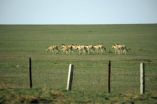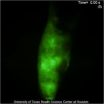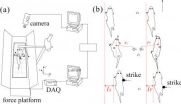(Press-News.org) The Gobi-Steppe Ecosystem is world renowned for its populations of migratory ungulates, which cover great distances in search of forage. Researchers at the Research Institute of Wildlife Ecology at Vetmeduni Vienna have documented, that in just one year an individual wild ass can range over an area of 70,000 km2. "Wild asses and gazelles have to be permanently on the move and travel very long distances to find enough food. Rainfall is highly variable in this region. As a consequence pastures are patchy and unpredictable in space and time," explains Petra Kaczensky, one of the authors from the Vetmeduni Vienna.
Barriers to migration
Although vast stretches of land remain largely unaltered, migratory species face a number of obstacles that disrupt their journey and affect their ability to survive and reproduce in this highly variable environment. The main obstacles of the recent past are fences erected along the international borders with Russia and China and the Trans Mongolian Railroad. The railroad fence now constitutes the de facto eastern border for the Asiatic wild ass, cutting the population off from its former much larger range to the east. Gazelles have also been largely restricted to either side of the railroad, but when they do attempt to cross they often get entangled or turned away. On its rapid path of economic development, Mongolia continues to build roads and new railway lines that are expected to threaten the ecological phenomenon of wildlife migration, if not carefully planned for.
Science can inform regional planning
Structural modifications could be made to fences, unnecessary fences could be removed in areas where there are no livestock, and planned railway lines could be re-routed to avoid sensitive areas. "We advocate a development process that minimizes negative effects on the integrity of the ecosystems such as following existing roads between villages to avoid large uninhabited regions while also incorporating the necessary designs so that they do not become new barriers; at the same time known barriers need to be removed," says corresponding author Kirk Olson from Fauna & Flora International, a global conservation organization based in the UK. "Regional planners need to think big - meaning on the scale of the migrations," adds author Nyamsuren Batsaikhaan from the National University of Mongolia.
A responsibility to link science and policy
Research into the movement and habitat requirements of the species roaming Mongolia´s Gobi-Steppe Ecosystem is ongoing, but needs to continue to identify potential conflicts between development efforts and biodiversity conservation requirements. Science can and should play a role in planning processes, according to Chris Walzer of the Vetmeduni Vienna, another author of the paper. "It is also among the responsibilities of a university to provide that link between science and policy making. Scientists can provide constructive inputs in fields such as wildlife management and conservation," Walzer emphasizes. "I think that if we do not translate our findings into practical advice that non-scientists can use, we have failed in our educational mission." In the case of Mongolia, the authors are hopeful that joint efforts will lead to the preservation of the country´s outstanding natural heritage for future generations.
INFORMATION:
The article "Conserving the World's Finest Grassland Amidst Ambitious National Development" by N. Batsaikhan et al. was recently published in the journal Conservation Biology.
About the University of Veterinary Medicine, Vienna
The University of Veterinary Medicine, Vienna in Austria is one of the leading academic and research institutions in the field of Veterinary Sciences in Europe. About 1,200 employees and 2,300 students work on the campus in the north of Vienna which also houses five university clinics and various research sites. Outside of Vienna the university operates Teaching and Research Farms. http://www.vetmeduni.ac.at
Scientific Contact:
Dr. Petra Kaczensky
Research Institute for Wildlife and Ecology
University of Veterinary Medicine Vienna (Vetmeduni Vienna)
M: +43 6767379650
petra.kaczensky@vetmeduni.ac.at
Released by:
Susanna Kautschitsch
Science Communication / Public Relations
University of Veterinary Medicine Vienna (Vetmeduni Vienna)
T +43 1 25077-1153
susanna.kautschitsch@vetmeduni.ac.at
Breaking down barriers
An appeal to conserve migratory ungulates in Mongolia's grasslands
2014-06-03
ELSE PRESS RELEASES FROM THIS DATE:
Lasers and night-vision technology help improve imaging of hidden lymphatic system
2014-06-03
VIDEO:
This is a movie illustrating the lack of lymphatic flow in the lower leg of a subject with lymphedema.
Click here for more information.
WASHINGTON, June 3, 2014—The human lymphatic system is an important but poorly understood circulatory system consisting of tiny vessels spread throughout the body. This "drainage" network helps guard against infections and prevents swelling, which occasionally happens when disease or trauma interrupts normal lymphatic function. Chronic ...
Security guard industry lacks standards, training
2014-06-03
EAST LANSING, Mich. --- Despite playing a more important role in the wake of 9/11, the security guard industry remains plagued by inadequate training and standards in many states, indicates new research by Michigan State University criminologists.
Formal training of the nation's 1 million-plus private security officers is widely neglected, a surprising finding when contrasted with other private occupations such as paramedics, childcare workers and even cosmetologists, said Mahesh Nalla, lead investigator and MSU professor of criminal justice.
By and large, security ...
Balancing strategy to lateral impact in a rat Rattus norregicus
2014-06-03
The balancing strategy to lateral impact in a rat is closely related to the striked position of the body. The research result can be inspired to improve the robustness of bionic robot. This was found by Dr. JI Aihong and his group from Institute of Bio-inspired Structure and Surface Engineering, Nanjing University of Aeronautics and Astronautics. This work, entitled "Balancing strategy to lateral impact in a rat Rattus norregicus", was published in Chinese Science Bulletin (In Chinese),2014, Vol 59(13) issue.
The center of mass(COM) of animal's body always falls ...
Modeling and simulation in the big data era
2014-06-03
The big data era bring the confusions, challenges and opportunities to the modeling and simulation field tightly associated with big data. The Chinese Association for System Simulation undertook the 81st new ideas and new theories academic salon of China Association for Science and Technology. This salon, directed by Li Bohu (academician of Chinese Academy of Science) and Hu Xiaofeng (professor of National Defense University, PLA) as the leading scientists, called about 20 specialists and scholars from all the country together. They deeply investigated big data from different ...
Scientists uncover features of antibody-producing cells in people infected with HIV
2014-06-03
WHAT:
By analyzing the blood of almost 100 treated and untreated HIV-infected volunteers, a team of scientists has identified previously unknown characteristics of B cells in the context of HIV infection. B cells are the immune system cells that make antibodies to HIV and other pathogens. The findings augment the current understanding of how HIV disease develops and have implications for the timing of treatment. Researchers at the National Institute of Allergy and Infectious Diseases, part of the National Institutes of Health, led the study.
Using advanced tools to probe ...
The quest for the bionic arm
2014-06-03
ROSEMONT, Ill.—In the past 13 years, nearly 2,000 veterans returned from Iraq and Afghanistan with injuries requiring amputations; 14 percent of those injured veterans required upper extremity amputations. To treat veterans with upper extremity amputations, scientists continue to pursue research and development of bionic arms and hands with full motor and sensory function. An article appearing in the June issue of the Journal of the American Academy of Orthopaedic Surgeons (JAAOS) reviews the recent advancements in upper extremity bionics and the challenges that remain ...
Stopping the spread of breast cancer
2014-06-03
CHICAGO – The primary cause of death from breast cancer is the spread of tumor cells from the breast to other organs in the body. Northwestern Medicine® scientists have discovered a new pathway that can stop breast cancer cells from spreading.
Working with human breast cancer cells and mouse models of breast cancer, scientists identified a new protein that plays a key role in reprogramming cancer cells to migrate and invade other organs. When that protein is removed from cancer cells in mice, the ability of the cells to metastasize to the lung is dramatically decreased.
The ...
A new look at old forests
2014-06-03
WOODS HOLE, Mass.— As forests age, their ability to grow decreases, a new study by Marine Biological Laboratory (MBL) scientists and colleagues has determined. Since most U.S. forests are maturing from regeneration that began about 100 years ago when extensive clear-cutting occurred, the study suggests the future growth of U.S. forests will decline.
"All forests are in succession: They get old, die (due to fire, insects, hurricane, etc.), and regenerate. This paper improves on a fundamental theory in ecosystem development: How a forest evolves over time. It demonstrates ...
With developing world's policy support, global renewable energy generation capacity jumps to record
2014-06-03
The number of emerging economy nations with policies in place to support the expansion of renewable energy has surged more than six-fold in just eight years, from 15 developing countries in 2005 to 95 early this year.
Those 95 developing nations today make up the vast majority of the 144 countries with renewable energy support policies and targets in place, says REN21's Renewables 2014 Global Status Report. And the rise of developing world support contrasts with declining support and renewables policy uncertainty and even retroactive support reductions in some European ...
Liver cancer vaccine effective in mice
2014-06-03
AUGUSTA, Ga. – Tweaking a protein expressed by most liver cancer cells has enabled scientists to make a vaccine that is exceedingly effective at preventing the disease in mice.
Alpha-Fetoprotein, or AFP – normally expressed during development and by liver cancer cells as well – has escaped attack in previous vaccine iterations because the body recognizes it as "self," said Dr. Yukai He, immunologist at the Medical College of Georgia and Georgia Regents University Cancer Center.
Liver cancer is among the fastest-growing and deadliest cancers in the United States with ...
LAST 30 PRESS RELEASES:
University of Oklahoma researcher awarded funding to pursue AI-powered material design
Exploring how the visual system recovers following injury
Support for parents with infants at pediatric check-ups leads to better reading and math skills in elementary school
Kids’ behavioral health is a growing share of family health costs
Day & night: Cancer disrupts the brain’s natural rhythm
COVID-19 vaccination significantly reduces risk to pregnant women and baby
The role of vaccination in maternal and perinatal outcomes associated with COVID-19 in pregnancy
Mayo Clinic smartwatch system helps parents shorten and defuse children's severe tantrums early
Behavioral health spending spikes to 40% of all children’s health expenditures, nearly doubling in a decade
Digital cognitive behavioral treatment for generalized anxiety disorder
Expenditures for pediatric behavioral health care over time and estimated family financial burden
Air conditioning in nursing homes and mortality during extreme heat
The Alps to lose a record number of glaciers in the next decade
What makes a good proton conductor?
New science reporting guide published for journalists in Bulgaria
New international study reveals major survival gaps among children with cancer
New science reporting guide published for journalists in Turkey
Scientists develop a smarter mRNA therapy that knows which cells to target
Neuroanatomy-informed brain–machine hybrid intelligence for robust acoustic target detection
Eight SwRI hydrogen projects funded by ENERGYWERX
The Lundquist Institute and its start-up company Vitalex Biosciences Announces Strategic Advancement of Second-Generation fungal Vaccine VXV-01 through Phase 1 Trials under $40 Million Competitive Con
Fine particles in pollution are associated with early signs of autoimmune disease
Review article | Towards a Global Ground-Based Earth Observatory (GGBEO): Leveraging existing systems and networks
Penn and UMich create world’s smallest programmable, autonomous robots
Cleveland researchers launch first major study to address ‘hidden performance killer’ in athletes
To connect across politics, try saying what you oppose
Modulating key interaction prevents virus from entering cells
Project explores barriers to NHS career progression facing international medical graduates
Jeonbuk National University researchers explore the impact of different seasonings on the flavor perception of Doenjang soup
Two Keck Medicine of USC Hospitals named Leapfrog Top Teaching Hospitals
[Press-News.org] Breaking down barriersAn appeal to conserve migratory ungulates in Mongolia's grasslands






